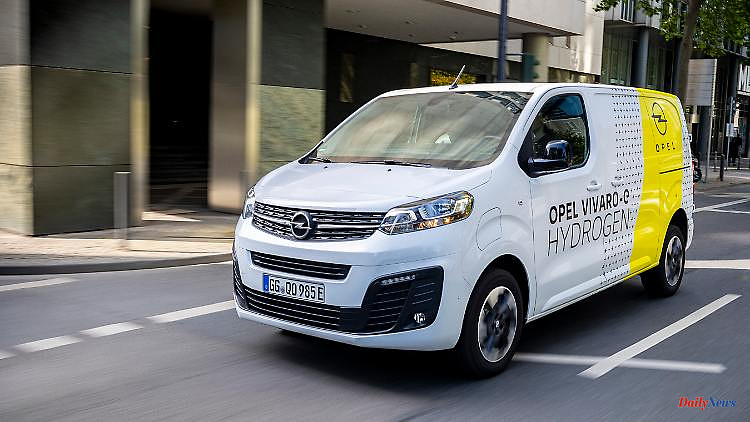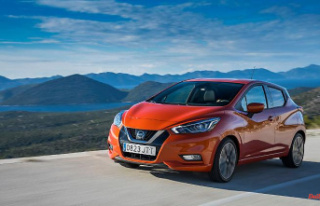The fuel cell was voted out before it had a chance to really take center stage. Now Opel is starting a new venture with the Opel Vivaro-e Hydrogen on behalf of the Stellantis Group. The transporter should be an alternative to diesel vehicles, especially for fleet customers.
Driving quietly and without emissions and recharging energy quickly: With these arguments, Stellantis wants to convince van customers of the hydrogen drive. The group therefore offers a hydrogen variant for its Citroën Jumpy, Opel Vivaro and Peugeot Expert vans. The base vehicle is the respective electric offshoot. Opel was in charge of the implementation and production of these vehicles in the multi-brand group.
In Rüsselsheim, the e-transporters are converted in small series. The large traction battery is removed and in its place three 700 bar hydrogen tanks are placed in the underbody, which hold up to 4.4 kilograms of hydrogen and enable a range of up to 350 kilometers. The 45 kW fuel cell and its components are located in the engine compartment. The 136 hp electric motor remains unchanged. The technicians install a 10.5 kWh battery under the seats; it is charged via the 11 kW onboard charger and allows a range of around 50 kilometers. A lot of effort, but it should pay off. For Opel Germany boss Andreas Marx, the Vivaro-e Hydrogen is a great opportunity to advance the topic of e-mobility. "Hydrogen technology is a door opener to get in touch with fleets that are looking for long-range alternatives to combustion engines and to convince them of our expertise in electric drives."
Representing the Stellantis brands, the Opel Vivaro-e Hydrogen was available for initial test drives. At first glance, the Transporter, which is available in two lengths (5.00 and 5.31 metres), cannot be distinguished from the conventionally powered versions. The typical shapes designed for loading capacity are also style-defining for the Hydrogen. The cargo space is also quite conventional. Like the E-Transporter, the Hydrogen also has the same storage space as the Diesel. Depending on the length of the vehicle, the loading volume is 5.3 or 6.1 cubic meters. He can load up to a ton, a decent value. The Vivaro-e only weighs 750 kilograms. He can also take a ton on the hook. Here, however, the diesel variants are superior. Depending on the engine, the trailer load is between 1800 and 2500 kilograms.
The interior is familiar from the conventional Vivaro models. The differences - especially to the battery-electric Opel - are marginal and can be seen in the cockpit displays, which have been expanded to include a level indicator for the hydrogen tanks. The operation does not present the driver with any puzzles, so the key is turned and the automatic is set to D. Quiet running is very typical. You can't hear anything from the drivetrain apart from a soft murmur. As with the battery-electric Vivaro, the response of the engine can be selected via three driving modes (Eco, Normal, Sport). The Eco is very relaxed, ideal for driving in the city. If you are in a hurry, the sport mode helps. Here the 136 hp are available in their entirety. To cover peak loads, the 10.5 kWh battery provides support when accelerating. However, the Vivaro does not turn into a miracle of acceleration: the top speed is specified as 110 km/h, the "sprint" to country road speed takes 15 seconds.
More important than speed on the road, however, is the simple and quick refueling of the three hydrogen tanks. The filling at the column is done in three minutes. On average, 1.3 kilograms of hydrogen are sufficient for a distance of 100 kilometers. At a price of just under 13 euros per kilogram, the Vivaro-e Hydrogen is a little cheaper than the diesel variants, which according to the standard consume around seven liters, given the currently high fuel costs. However, with currently 95 filling stations, the public hydrogen tank network in Germany is still thin and unevenly distributed. If the worst comes to the worst, the battery should offer a range buffer to get to a gas station.
Speaking of costs: Opel does not name a price. The vehicles are only offered for leasing and, thanks to state subsidies, come to a monthly rate of 700 euros. From the factory, the Hydrogen has, among other things, a navigation system, the three-phase onboard charger and a reversing camera. But it should not stop with this one hydrogen model. For 2024, the large vans (Citroën Jumper, Opel Movano, Peugeot Boxer) will also be available as hydrogen versions. A hydrogen-powered pick-up is also planned for the US market from 2025.












